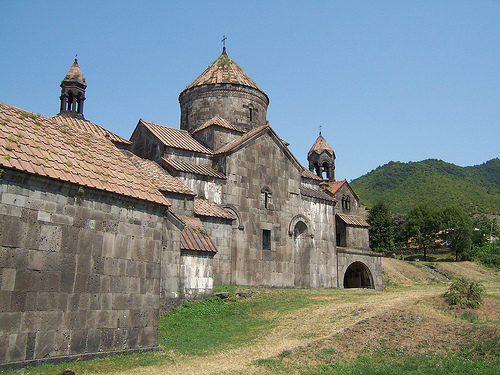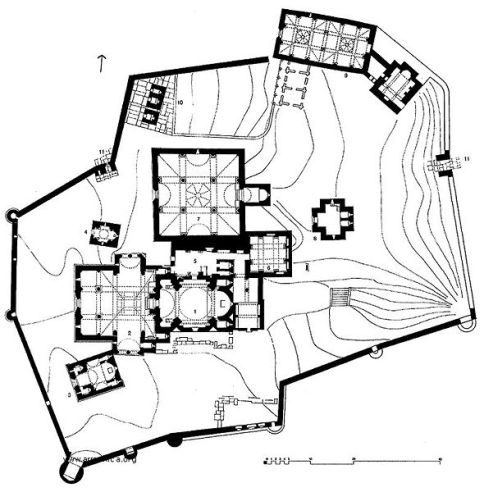

Location: Haghpat, Lori Province Map
Found: 10th century by Saint Nishan (Sourb Nshan)
Haghpat Monastery located in Haghpat, Lori Province of Armenia was found in 10th century by Saint Nishan (Sourb Nshan). Along with nearby Sanahin monastery, Haghpat Monastery is added to the list of UNESCO World Heritage Sites. The largest church of Haghpat abbey is a Cathedral of Saint Nishan that was constructed between 967- 991 AD thanks to donations of Armenian Prince Khutulukhaga. A small domed Church of Saint Gregory (Sourb Grigor) the Illuminator is situated near by. Additionally the Haghpat Monastery contains hall (gavit) of Amazasp (1257), refectory (mid- XIII century), crypt of Ukanyants with a chapel and many more structures. Like many medieval Christian monasteries Haghpat monastery became a center of education and studies. Monks studied medicine, history, literature and created beautiful frescoes. Haghpat monastery was badly damaged by constant invaders from the south, however with Armenian annexation by the Russian Empire these attacks largely stopped.
Haghpat monastery quickly grew in size until the beginning of the 20th century when Russian Revolution of 1917 reached here. As it happened across former USSR atheists closed all monasteries and churches. Monks and nuns either ran away or were executed. Haghpat Monastery was no exception to this horrible fate. After the collapse of Soviet Union and fall of Communism this Christian monastery was returned to its rightful owners, Armenian Apostolic Church. Today it is again an active monastery. Be aware that you shouldn't enter the altar of the church without permission.
The monastery is located on a small plateau surrounded by gorges. It was founded in 976 under Ashot III the Merciful. At the base of the monastery, Queen Hosrovanush played a significant role. In the X-XIII centuries it was one of the centers of the spiritual culture of Armenia, a large monastic possession, which had extensive land. From the second half of the 12th century, Haghpat became the spiritual and religious center of the Lori kingdom. Here, from the neighboring Sanahin, the tomb of the royal family of the Lorian Bagratids - the Kyurikids, was transferred. In 1081, the bishop of Ani and Shirak Barsegh was ordained a Catholicos in Haghpat, which testifies to the Pan-Armenian significance of the monastery. Since the end of the XI century, Lori (Tashir-Dzoraget), like the whole of Armenia, has been subjected to raids by the Seljuk Turks, in 1105 the monasteries of Haghpat and Sanahin were plundered by the emir Kzyl, and in 1118 the kingdom fell. The Tashir-Dzoraget territory was liberated from the Seljuks and annexed to Georgia by David the Builder. From the second half of the XII century, Haghpat belonged to the Armenian princely families of Artsruni, then Zakharyan. In the XV-XVII centuries, the influence of the Zakaryan clan weakened, henceforth, the rulers ("paron tery") stayed in the monastery, combining princely and spiritual authority. Throughout the XVII-XVIII centuries, due to frequent attacks by Lezgins, the Primate of Haghpat was forced to stay in Tiflis. In the second half of the 18th century, the famous poet Sayat Nova lived in the monastery for several years. In the late Middle Ages, the destinies of the Armenian Church on the territory of Georgia, Imereti, Abkhazia, Borchal and Kasakh, except for Sanahin, were subordinate to Archbishop Haghpat. In 1822-1826, due to the aggravation of Russian-Iranian relations, Catholicos Eprem I moved from Echmiadzin to Haghpat. After the accession of Eastern Armenia to Russia, the monastery became the spiritual center of Somhit and Kasakh with vast lands, villages, etc. At the beginning of the 20th century, Haghpat emptied, having lost most of its possessions. Reopened under Catholicos Wazgen I, it is currently a functioning monastery.

The Surb Nshan Church (Holy Signs, 972–991, 1016)
with a narthex (1185, 1209), the oldest surviving building of the
monastery, was founded by Queen Khosrovanush, wife of the Armenian
king Ashot III Bagratuni. It is believed that the architect of Trdat
was the construction leader of the Surb Nshan church. The interior
of the temple is a magnificent domed hall. Fragments of the mural of
the beginning of the 13th century on the altar have been preserved;
the murals contain Armenian and Georgian inscriptions. On the
eastern facade there is a sculptural image of the sons of Ashot -
Smbat and Kyurike, holding a model of the temple in their hands.
Curiké's headdress is like a miter, and Smbat's turban is an Arabian
regalia showing his right to the throne as overlord. In 1313, the
northern wall was painted at the direction of a prominent political
figure, Paron Sadun. Then on the south wall was a portrait of the
son of Sadun Khutlubugi. On the eve of the Surb Nshan church there
is a zhamatun (narthex), built in 1185 and serving as the tomb of
the Kyurikyan. In 1223, by the order of Ivane Zakharyan, the Haghpat
monastery complex was surrounded by fortified walls with towers. It
included:
Surb Grigor Lusavorich Church (St. Gregory the Illuminator), built
in 1005 and then rebuilt in 1211,
the small domed church of Surb Astvatsatsin or Hatunashen, built in
1025,
Gavit Amazaspa - a spacious hall with 4 columns, the largest among
the similar in Armenia, built in 1257,
the tomb of the Ukanyants clan with chapels crowned with khachkars,
among which Amenaprkich stands out by execution (All-Savior, 1273),
a book depository of the middle of the 11th century, then rebuilt in
1258–1262,
refectory of the middle of the XIII century.
A separate three-tier belfry (1245) with a seven-sided belfry
rotunda served as a model for later bell towers, for example, in
Kars.
In the 11th – 15th centuries, the scriptorium and school founded in
Haghpat in the 10th century by the first rector of the monastery,
the famous scribe wardap Simeon, became widely known in Armenia.
Outstanding figures of Armenian science and culture Hovhannes
Imastaser, Samuel Anetsi, Yeremiah Andzrevik, David Kobayretsi,
Hovhannes Erznakatsi and others taught grammar, rhetoric,
philosophy, theology, music and so on. In the monastery, manuscripts
were not only created, but also restored, textual work was carried
out, in particular, the Psalms and the “Announcing and secret
teachings” of Cyril I of Jerusalem were studied. Haghpat was famous
for its miniature school, here the famous monument of miniature
“Haghpat Gospel” (1211) was created.
In the XI century, a library was built near the
Surb Nshan church at the monastery, which became the richest
collection of Armenian medieval manuscripts, later they were
transferred to nearby caves, where reading rooms were arranged, for
better preservation. The famous Mugni Gospel (now in Matenadaran)
was kept in Haghpat. Among the lost manuscripts, “Kotuk” (the
traditions of the monastery of Haghpat) was of special value, the
list of the Bible of 951 is mentioned. In 1931, only 12 manuscripts
were brought from Haghpat to Yerevan, the rest are considered lost.
Behind the fence of the monastery is a small chapel of the
thirteenth century, a splendidly architectural spring (XIII
century). Haghpat's monuments are distinguished by compactness, the
severe severity of forms, the elegance of a few decorative details,
the wit of space decisions, designs.
And almost in the middle between Haghpat and Sanahin, there is an
interesting fortress called Kayanberd or Haghpat Surb Nshan, which
was built in the XIII century